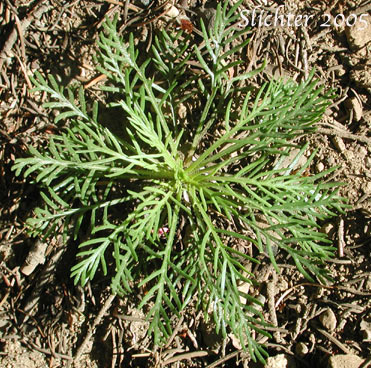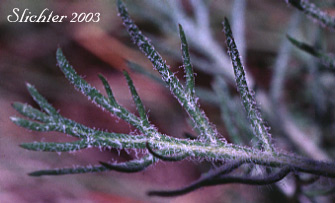 The photo at right shows the basal rosette of leaves of scarlet gilia as seen along Forest Road #82 on the south side of Mt. Adams.........July 1, 2005. Typically a biennial, this is what the plant looks like for the first year, and early in the second year of bloom.
The photo at right shows the basal rosette of leaves of scarlet gilia as seen along Forest Road #82 on the south side of Mt. Adams.........July 1, 2005. Typically a biennial, this is what the plant looks like for the first year, and early in the second year of bloom.
Scarlet gilia is a strikingly beautiful wildflower. It is a favorite of hummingbirds, and makes a nice addition to the dry, eastside (east of the Cascades) meadow or rock garden. It is a biennial, or a short-lived perennial. From experience, it is difficult to get it to over-winter outdoors west of the Cascades, as it is quite susceptible to the dampness and fungal attack.
Scarlet gilia has one erect, usually unbranched stem that may reach a height of 100 cm. The leaves are basal and also found on the stem (See photo at right.). The stem leaves become reduced in size upwards on the stem. They are usually 2-5 cm long, occasionally to 10 cm long, and are pinnatifid and very dissected. The herbage ranges from glabrous to tomentose.
The inflorescence is glandualr, open, and long and narrow. The flowers are clustered near the ends of the branches. The calyx is 5-7 mm long. The corolla is very showy, with a long, gradually flared tube from 15 to 35 mm long, with the spreading lobes 6 to 13 mm long. The corolla is an intense scarlet or occasionally whitish with scarlet spots.Scarlet gilia is found from the lowlands to well up in altitude in mountainous areas. It prefers dry meadows, open or lightly wooded, and often in rocky or cliff areas.
Scarlet gilia is found from southern British Columbia, south along the eastern side of the Cascades (occasionally west) to Mexico.
